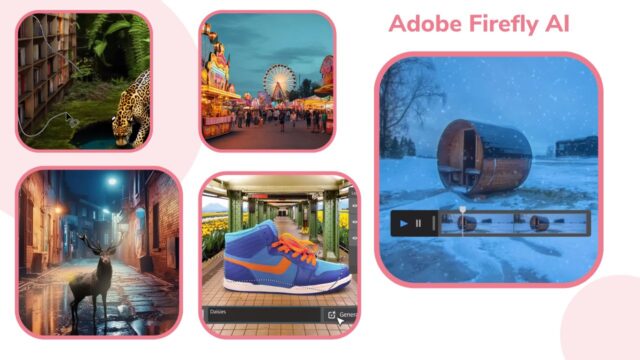Adobe’s Firefly is among the latest AI-powered image generators making waves in the creative world. This DALL-E competitor seamlessly integrates with Photoshop and offers a host of exciting features that we’ll delve into.
At its core, Adobe Firefly specializes in AI-driven image generation, allowing users to fine-tune prompts and styles to craft unique pieces of art. But here’s where it gets really exciting: Adobe has future plans to expand Firefly’s capabilities, enabling its neural networks to generate brushes, vectors, and more, essentially serving as creative tools in their own right.
Imagine the possibilities of Firefly creating custom Photoshop brushes that align perfectly with your artistic vision with just a few clicks. Picture it effortlessly transforming daytime footage into a stunning nocturnal scene in an instant. It’s truly mind-boggling.
It’s worth noting that some Firefly-generated art may bear resemblance to Adobe Stock resources, but this also opens up new and uncharted avenues for artistic workflows. For Adobe users and content creators, the future appears exceptionally bright with the potential Firefly brings to the creative table.
Do you Need an Adobe Subscription for Firefly?
During the beta phase, using Firefly didn’t require a subscription. However, it’s reasonable to expect that once the testing phase concludes, access to Firefly will likely be restricted to a paid service.
Additionally, it’s unclear whether Firefly will continue to exist as a standalone app or if it will become integrated into Adobe’s other services. Adobe’s existing AI offerings, such as Neural Filters, are typically accessible through Photoshop and require a subscription.
We can reasonably assume that subscribers may receive priority access to Firefly when it transitions to a paid service.
What can Firefly do right now?
Currently, Firefly offers two useful tools: a text-to-image generator and a Text Effects creator. However, it’s important to note that neither of these tools can directly output to Photoshop or Illustrator files at the moment. Instead, they save the generated content as watermarked images.
The good news is that Adobe has plans to introduce a vector recolor feature in the near future, which will likely enhance the capabilities of these tools. This means users can look forward to more versatile and creative options when working with text and images in Firefly.
Does Adobe train the AI with consumer photographs and art?
According to Adobe, they currently don’t have access to any files that users create to train Firefly. However, it’s worth noting that this situation may evolve as Firefly becomes more widely available. Nonetheless, considering the extensive content library already present on Adobe Stock, it doesn’t appear that they have immediate plans to make such changes anytime soon.
AI and Adobe
Adobe has been no stranger to the world of AI. They’ve been incorporating various forms of machine learning technology and algorithms into their suite of programs since late 2015. One of the most popular applications of this technology is seen in Adobe’s “Content-Aware” tools, which are available in Photoshop and After Effects.
The Content-Aware feature empowers creators to select a specific area in an image or video and, thanks to the magic of behind-the-scenes tools like Adobe Sensei, generate and seamlessly integrate a new section into the composition. For example, if there’s an unwanted tree obstructing a shot, you can simply remove it, and the background will be automatically reconstructed using the surrounding elements. This functionality extends to video editing in After Effects as well.
Now, Adobe has plans to integrate Firefly into their full suite of software, but there’s no concrete timeline for when or how this will happen. As of now, Firefly is in a limited beta phase, and during this testing period, it does have its limitations. Notably, users can’t export or upload video content, and it’s not designed for editing or refining existing artwork, despite this being a prominent feature teased on the platform.
















